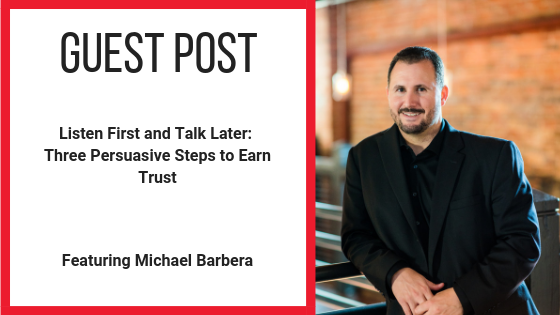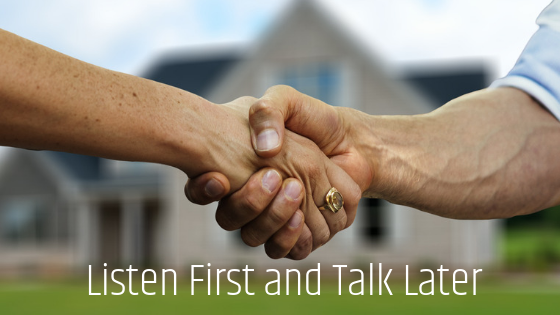Guest Post | Listen First and Talk Later: Three Persuasive Steps to Earn Trust
September 13, 2018This week we have Michael Barbera, chief behavioral officer at Clicksuasion Labs, on the blog! He’s sharing his three tips to earn trust with your prospective clients. We have such a short time to make a great impression with leads and we need to make it good! Read more below!
 Three-to-five seconds is all it takes for a potential client to believe if they trust you when meeting for the first time. Imagine, one-one thousand, two-one thousand, three-one thousand…I don’t trust you. Shocking, subjective and stressful, yet true. Although the perception of trust or lack thereof is present, there is still a way to build a greater amount of trust with clients: be authentic, be unique and give them your full attention.
Three-to-five seconds is all it takes for a potential client to believe if they trust you when meeting for the first time. Imagine, one-one thousand, two-one thousand, three-one thousand…I don’t trust you. Shocking, subjective and stressful, yet true. Although the perception of trust or lack thereof is present, there is still a way to build a greater amount of trust with clients: be authentic, be unique and give them your full attention.
When a client objects to your authority or expertise, you are likely to overcompensate in other areas in an attempt to gain their trust. However, we could gain trust without saying a word. Active listening requires giving all of your attention to the other person. Verbal persuasion could be applied after being an active listener.
Step One: Look & Touch
Consistent eye contact when communicating with a potential client is likely to give the other person the impression they are important and being heard. In conjunction with consistent eye contact, a firm two-hand handshake could immediately alter the client’s perception of how much they are willing to trust you. When you shake a client’s hand, square up your shoulders, maintain eye contact, shake their hand with your right hand and simultaneously place your left hand on their right elbow. Try to avoid leaning towards the other person. The additional physical contact is likely to trigger a thought of uniqueness. Being unique is memorable.
Step Two: Hide the Cell Phone
A visible cell phone gives the impression that the other person must compete for your attention. The potential client is likely to believe they are less important than everything and everyone connected to your phone.
Step Three: The Body Tells a Story
There is a misconception that we should mimic other people’s body language when negotiating or attempting to be persuasive. Decision research suggests that maintaining an independent body language could be more persuasive. Being independent and not replicating other people’s behavior is likely to display your authority. The individual who changes their body language is likely to be the person who feels they have less authority and are more likely to agree with the other person’s statements and recommendations.
Be yourself, be authentic and be allow the other person to communicate with a person who is actively listening. Once it is your opportunity to speak: be bold, be brief and be gone.
About the Author
Michael Barbera, chief behavioral officer at Clicksuasion Labs, is an award-winning consumer psychologist and business strategist. His clients include Fortune 500 companies and have appeared on ABC’s Shark Tank, Bravo’s Million Dollar Listing, and Gordon Ramsay’s Kitchen Nightmares. Michael’s business psychology practice includes consumer behavior, emotions, and experiences, as well as social psychology, decision-making, behavioral economics, and behavioral finance. He shares his evidence-based insights as host of the Clicksuasion podcast and as a dynamic TEDx presenter. Michael is also a celebrated keynote speaker, and has addressed more than 100,000 people on four continents, earning more than 250,000 views online. You can also find him on Twitter.
Related Posts:
Categorised in: Guest Blogs, Home Builder Marketing & Sales, Thoughtful Thursdays










